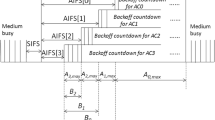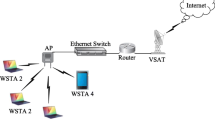Abstract
Mathematical modeling and performance analysis of the IEEE 802.11e Enhanced Distributed Channel Access (EDCA) has been the subject of several research papers published in the literature. However, the Packet Fragmentation (PF) which has been proposed by the IEEE work group in the legacy IEEE 802.11 standard, has never been taken into account in the mathematical models available in the literature, in order to analyze the performance of the IEEE 802.11e-EDCA network under the influence of the Packet Error Rate (PER). Yet, the Packet Fragmentation is the only existing solution since 1999, which allows reducing the influence of the PER on the performance of IEEE 802.11 networks. In this paper, we aim at showing for the first time, how the Packet Fragmentation developed in the legacy IEEE 802.11 standard can be used to enhance the current IEEE 802.11e Quality of Service (QoS). Therefore, we propose an extension of the existing Markov chain models of the IEEE 802.11e EDCA function, in order to take into account the Packet Error Rate and Packet Fragmentation. Furthermore, we develop a mathematical model to derive the saturation throughput of a given Access Category (AC), namely: Voice (VO), Video (VI), Best Effort (BE) and Background (BK). The obtained analytical results show that, applying the Packet Fragmentation on the IEEE 802.11e-EDCA network, allows improving the utilization of the scarce wireless bandwidth under the impact of PER parameters, namely: Bit Error Rate (BER) and packet length.












Similar content being viewed by others
References
Al-Karaki JN, Chang JM (2004) Quality of service support in IEEE 802.11 wireless Ad Hoc networks. Ad Hoc Netw 2:265–281
Banchs A, Vollero L (2006) Throughput analysis and optimal configuration of 802.11e EDCA. Comput Netw 50:1749–1768
Banchs A, Serrano P (2007) Revising 802.11e EDCA performance analysis. Wirel Personal Commun 43:1145–1149
Bianchi G (2000) Performance analysis of the IEEE 802.11 districuted coordination function. IEEE J Sel Areas Commun 18:535–547
Bolch G, Greiner S, de-Meer H, Trivedi K S (2006) Queueing networks and Markov chains: modeling and performance evaluation with computer science applications. Wiley, New Jersey
Camps-Mur D, Gomony MD, Perez-Costa X, Sallent-Ribes S (2012) Leveraging 802.11n frame aggregation to enhance QoS and power consumption in Wi-Fi networks. Comput Netw 56:2896–2911
Casale G, Gribaudo M, Serazzi G (2011) Tools for performance evaluation of computer systems: historical evolution and perspectives. In: Performance evaluation of computer and communication systems. Milestones and future challenges. IFIP WG 8.3/7.3 international workshop, PERFORM 2010, volume 6821 of LNCS, pp 24–37
Cetinkaya C (2010) Service differentiation mechanisms for WLANs. Comput Netw 8:46–62
Fan Z (2007) Throughput and QoS optimization for EDCA-based IEEE 802.11 WLANs. Wirel Personal Commun 43:1279–1290
Gallardo J, Medina P, Zhuang W (2007) QoS mechanisms for the MAC protocol of IEEE 802.11 WLANs. Wirel Netw 13:335–349
Ge Y, Hou JC, Choi S (2007) An analytical study of tunning systems parameters in IEEE 802.11e enhanced distributed channel access. Comput Netw 51:1955–1980
Giustiniano D, Malone D, Leith DJ, Papagiannaki K (2010) Measuring transmission opportunities in 802.11 Links. IEEE/ACM Trans Netw 18(5):1516–1529
Hamidian A, Korner U (2006) An enhancement to the IEEE 802.11e EDCA providing QoS guarantees. Telecommun Syst 31:195–212
Hamidian A, Korner U (2008) Extending EDCA with distributed ressource reservation for QoS guarantees. Telecommun Syst 39:187–194
He Y, Sun J, Ma X, Vasilakos AV, Yuan R, Gong W (2013) Semi-random backoff: towards resource reservation for channel access in wireless LANs. IEEE/ACM Trans Netw 21(1):204–217
IEEE 802.11 Standard Part II, Wireless LAN medium access control (MAC) and physical (PHY) specifications, (1999)
IEEE 802.11e Standard Part II ,Wireless LAN medium access control (MAC) and physical (PHY) specifications, Amendement 8: medium access control (MAC) quality of service enhancements, (2005)
Hu J, Min G, Woodward ME (2011) Performance analysis of the TXOP burst transmission scheme in single-hop Ad Hoc networks with unbalanced stations. Comput Commun 34:1593–1603
Hu J, Min G, Jia W, Woodward ME (2012) Comprehensive QoS analysis of enhanced distributed channel access in wireless local area networks. Inf Sci 214:20–34
Jeong S, Kim M, Ryu J, Jo D, Han K (2004) An analytical model for throughput of IEEE 802.11e EDCA. Springer-Verlag, Berlin Heidelberg, pp 304–312
Kong ZN, Tsang DHK, Bensaou B, Gao D (2004) Performance analysis of IEEE 802.11e contention-based channel access. IEEE J Sel Areas Commun 22(10):2095–2106
Korner U, Hamidian A, Pioro M, Nyberg C (2011) A distributed MAC scheme to achieve QoS in Ad Hoc networks. Ann Telecommun 66:491–500
Kosek-Szott K, Natkaniec M, Pach A R (2011) A Simple but accurate throughput model for IEEE 802.11 EDCA in saturation and non-saturation conditions. Comput Netw 55:622–635
Lagkas TD, Stratogiannis DG, Chatzimisios P (2011) Modeling and performance analysis of an alternative to IEEE 802.11e hybrid control function. Telecommun Syst. doi:10.1007/s11235-011-9477-5
Lee Y, Lee KS, Jang JM (2007) Saturation throughput analysis of IEEE 802.11e EDCA, 1223–1232. Springer-Verlag, Berlin Heidelberg
Lee JF, Liao W, Chen MC (2007) A differentiated service model for enhanced distributed channel access (EDCA) of IEEE 802.11e WLANs. Mobile Netw Appl 12:69–77
Lefebvre M (2007) Applied stochastic processes. Springer, New York
Lin WY, Wu JS (2007) Modified EDCF to improve the performance of IEEE 802.11e WLAN. Comput Commun 30:841–848
Liu X, Saadawi TN (2011) IEEE 802.11e (EDCA) analysis in the presence of hidden stations. J Adv Res 2:219–225
Lyakhov A, Vishnevsky VM (2004) Packet fragmentation in Wi-Fi Ad Hoc networks with correlated channel failures. IEEE Int Conf Mobile Ad Hoc Sensor Syst:204–213
Min G, Hu J, Woodward ME (2011) Modeling and analysis of TXOP differentiation in infrastructure-based WLANs. Comput Netw 55:2545–2557
Moltchanov D (2010) Performance models for wireless channels. Comput Sci Rev 4:153–184
Narayan-Bhat U (2007) An introduction to queueing theory: modeling and analysis in applications. Springer, New York
Pan SW, Wu JS (2009) Throughput analysis of IEEE 802.11 EDCA under heterogeneous traffic. Comput Commun 32:935–942
Park S, Chang Y, Copeland JA (2012) Throughput enhancement of MANETs: packet fragmentation with hidden stations and BERs. IEEE Consum Commun Netw Conf:188–193
Patras P, Banchs A, Serrano P (2009) A control theoretic for throughput optimization in IEEE 802.11e EDCA WLANs. Mobile Netw Appl 14:697–708
Pocta P, Bilsak M, Rousekova J (2010) Impact of fragmentation threshold tuning on performance of voice service and background traffic in IEEE 802.11b WLANs. In: 20th international conference on radioelektronika, pp 1–4
Puigjaner R (2003) Performance modelling of computer networks. In: Proceedings IFIP/ACM Latin America conference on towards a Latin American agenda for network research
Serrano P, Banchs A, Azcorra A (2007) A throughput and delay model for IEEE 802.11e EDCA under non saturation. Wirel Personal Commun 43:467–479
Sweedy AM, Semeia AI, Sayed SY, Konber AH (2010) The effect of frame length, fragmentation and RTS/CTS mechanism on IEEE 802.11 MAC performance. In: 10th International conference on intelligent systems design and applications, pp 1338–1344
Tao Z, Panwar SS (2004) An analytical model for the IEEE 802.11e EDCF. In: IEEE 13th workshop on local and metropolitan area networks (LANMAN), pp 39–44
Tao Z, Panwar S (2006) Throughput and delay analysis for the IEEE 802.11e enhanced distributed channel access. IEEE Trans Commun 54(4):596–603
Thangaraj A, Zeng Q A, Li X (2010) Performance analysis of the IEEE 802.11e wireless networks with TCP ACK prioritization. Telecommun Syst 45:303–312
Varposhti M, Movahhedinia N (2009) Supporting QoS in IEEE 802.11e wireless LANs over fading channel. Comput Commun 32:985–991
Vassis D, Kormentzas G (2005) Delay performance analysis and evaluation of IEEE 802.11e EDCA in finite load conditions. Wirel Personal Commun 34:29–43
Xiao Y (2005) Performance analysis of priority schemes for IEEE 802.11 and IEEE 802.11e wireless LANs. IEEE Trans Wirel Commun 4(4):1506–1515
Xiong L, Mao G (2007) Saturated throughput analysis of IEEE 802.11e EDCA. Comput Netw 51:3047–3068
Yao YC, Wen JH, Weng CE (2013) The performance evaluation of IEEE 802.11e for QoS support in wireless LANs. Wirel Personal Commun 69:413–425
Yu J, Choi S, Qiao D (2009) Analytical study of TCP performance over IEEE 802.11e WLANs. Mobile Netw Appl 14:470–485
Author information
Authors and Affiliations
Corresponding author
Rights and permissions
About this article
Cite this article
Yazid, M., Sahki, N., Bouallouche-Medjkoune, L. et al. Modeling and performance study of the packet fragmentation in an IEEE 802.11e-EDCA network over fading channel. Multimed Tools Appl 74, 9507–9527 (2015). https://doi.org/10.1007/s11042-014-2131-y
Received:
Revised:
Accepted:
Published:
Issue Date:
DOI: https://doi.org/10.1007/s11042-014-2131-y




